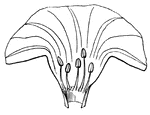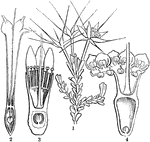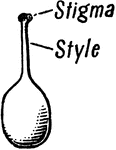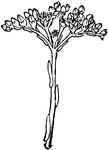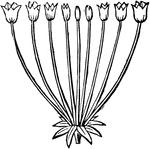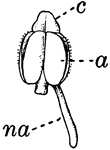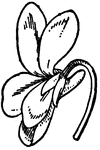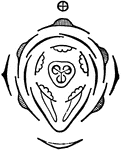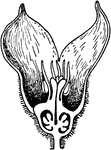The Flower Anatomy ClipArt gallery includes 418 illustrations of the parts of a flower.
Stamen of Globe Amaranth
Very short filament bearing a single anther-cell; it is open from top to bottom, showing the pollen…

Stamen of Mallow
Stamen of Mallow; the anther supposed to answer to that of Pentstemon pubescens, but the cells completely…
Stamen of Moonseed
Stamen of Moonseed, with anther cut across; this 4-celled, or rather 4-locellate.

Stamen of Pentstemon
Stamen of Pentstemon pubescens; the two-anther-cells diverging, and almost confluent.

Stamen Parts
"Parts of a stamen. A, front; B, back. a, anther; c, connective; f, filament." -Bergen, 1896

Stamens
Stamens of the mint family. Of a Monarda: the two anther-cells with bases divergent so that they are…
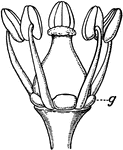
Stamens and Pistil
"Stamens and pistil of the grape, with a nectar gland, g, between each pair of stamens." -Bergen, 1896

Stilbe
"Stilbe Pinastra. 1. a flower; 2. the same cut open; 3. a perpendicular section of an ovary." -Lindley,…

Stitchwort
Stellaria is a genus of about 90-120 species flowering plants in the family Caryophyllaceae, with a…
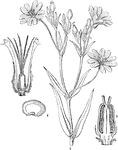
Greater Stitchwort
Stellaria holostea is an ornamental plant also known as Addersmeat or the Greater Stitchwort.

Structure of a Flower
Flower anatomy. A, sectional view of a flower showing the vertical disposition of whorls. a, sepal of…
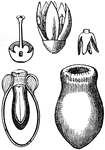
Struthanthus
"Details of the fructification of Struthanthus. 1. flower magnified; 2. section of calyx, ovary, and…
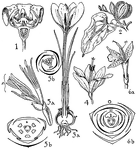
Taccaceae, Dioscoreaceae, Iridaceae, Musaceae, and Zingiberaceae Orders
Pictured are the Taccaceae, Dioscoreaceae, Iridaceae, Musaceae, and Zingiberaceae orders. Pictured are…

Algerian Tea
"Paronychia capitata. 1. a section of a flower; 2. of the ovary; 3. ripe seed; 4. a section of it."…
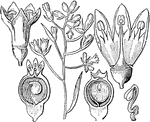
Thesium
"Thesium pratense. 1. a flower; 2. the same laid open; 3. half an unripe fruit; 4. placenta and pair…
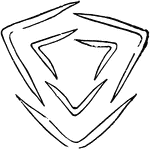
Three-ranked
Three-ranked arrangement, shown in a piece of the stalk of a Sedge. Diagram or cross-section, in one…

Orders of Thymelaeaceae, Elaeagnaceae, Lythraceae, and Punicaceae
Pictured are the orders of thymelaeaceae, elaeagnaceae, lythraceae, and punicaceae. The flowers of these…
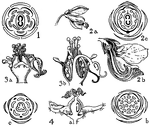
Orders of Tremandraceae, Polygalaceae, and Euphorbiaceae
The orders pictured are tremandraceae, polygalaceae, and euphorbiaceae. The flowers of these orders…
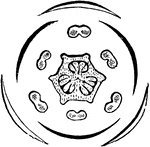
Trillium
Trillium is a genus of about 40-50 species of perennial herbaceous flowering plants, native to temperate…
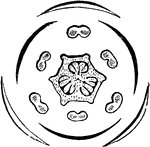
Trillium
Diagram of flower of Trillium. In this, as in all such diagrams of cross-section of blossoms, the parts…
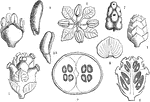
Turtleweed
"Batis maritima. 1. a male cone; 2. a male flower; 3. the same forced open to show the petals; 4. on…
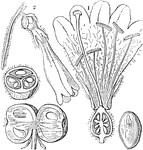
Twinflower
"1. flower of Linnaea borealis; 2. the same cut open and showing the interior of the ovary; 3. a cross…
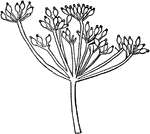
Umbels
"Umbel is formed when the secondary axes originate from the same point on the stem, and rise to nearly…
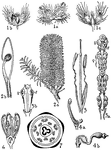
Urticaceae, Loranthaceae, and Olacaceae Orders
Shown are the Urticaceae, Loranthaceae, and Olacaceae orders. Urtica, banksia, protea, phoradendron,…

Valerian
"Valeriana celtica. 1. entire flower magnified; 2. the ovary and young calyx; 3. the fruit, with the…
![An illustration showing a "floral diagram of [the' Viola [plant], showing arrangement of parts in horizontal plan. b, pair of bractoeles below the flower; s, sepals; p, petals; st, stamens; o, ovary" (Britannica, 102).](https://etc.usf.edu/clipart/58100/58119/58119_viola-dia_mth.gif)
Viola Diagram
An illustration showing a "floral diagram of [the' Viola [plant], showing arrangement of parts in horizontal…
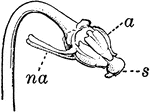
Viola Tricolor
Stames and pistil from a Viola tricolor. a Anther. na: Nectarial appendage of stamen.…
Anther Cells and Process of Viola Tricolor
A pictures the process of anther running into spur of viola tricolor. NC pictures the nectar cells,…
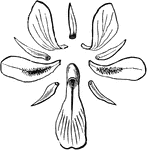
Violet
Its calyx and corolla displayed: the five smaller parts are the sepals; the five intervening larger…
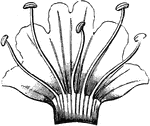
Viper's Bugloss Corolla and Stamens
Echium vulgare (Viper's Bugloss) is a species of Echium native to most of Europe, and western and central…
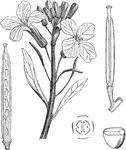
Aegean Wallflower
"Cheiranthus cheiri; 2. its stigma; 3. the same with one valve off; 4. a cross section of a seed; 5.…
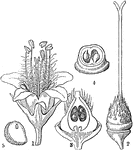
Bluntleaf Waterleaf
"Hydrophyllum canadense. 1. a flower; 2. a pistil; 3. a perpendicular section of the ovary; 4. a cross…
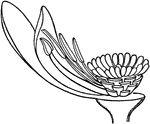
White Waterlily
"White water-lily. The inner petals and the stamens growing from the ovary." -Bergen, 1896
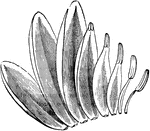
White Water-Lily
Series of sepals, petals, and stamens of White Water-Lily, showing the transitions.
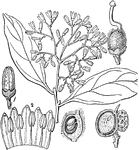
White-Pear
"Apodytes dimidiata. 1. a flower; 2. a corolla spread open; 3. a pistil; 4. section of an ovary; 5.…

